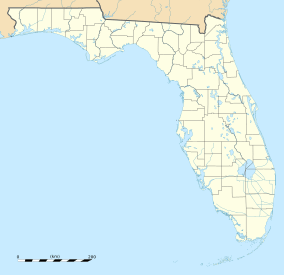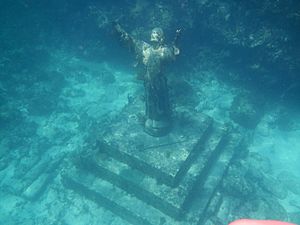John Pennekamp Coral Reef State Park facts for kids
Quick facts for kids John Pennekamp Coral Reef State Park |
|
|---|---|
|
IUCN Category IV (Habitat/Species Management Area)
|
|
| Location | Monroe County, Florida, U.S. |
| Nearest city | Key Largo, Florida |
| Area | 53,000 acres (210 km2) |
| Established | 1963 |
| Visitors | 1,000,000 (in 2004) |
| Governing body | Florida Department of Environmental Protection |
John Pennekamp Coral Reef State Park is a special state park located on Key Largo in Florida. It covers about 70 nautical square miles (240 km²) of the Atlantic Ocean waters nearby. This park is roughly 25 miles long and reaches 3 miles into the ocean.
It was the very first underwater park in the United States. The park was added to the National Register of Historic Places on April 14, 1972. The main things people love to see here are the amazing coral reefs, like Molasses Reef, and all the different sea creatures that live there.
In 2004, over a million people visited the park. This made it the most popular park in the Florida State Parks system. The Florida Keys and the Flower Garden Banks in the Gulf of Mexico are the only places with living coral reefs in the continental United States.
Contents
Park History and Creation
People started thinking about protecting the reefs near Key Largo way back in the 1930s. There was a plan to make a national park for the Everglades, which would include these reefs. But some local people and officials didn't agree with the idea.
When Everglades National Park was finally created in 1947, it did not include Key Largo or its reefs.
By the late 1950s, many people were worried about damage to the Florida Keys reefs. Tourists were taking seashells, corals, sponges, and sea horses. They were even using tools to break off pieces of the reef for souvenirs.
Dr. Gilbert L. Voss from the Marine Institute of Miami and John D. Pennekamp, an editor at the Miami Herald newspaper, decided to act. They worked together to protect the reefs. John Pennekamp was a great leader for this cause. He had helped create Everglades National Park and was a consultant for the United States Fish and Wildlife Service.
Because of their hard work, the state of Florida decided to make the reefs off Key Largo a permanent protected area. In the spring of 1960, President Dwight D. Eisenhower also declared the nearby federal waters as the Key Largo Coral Reef Preserve.
Later, Florida Governor Leroy Collins changed the park's name to John Pennekamp Coral Reef State Park. This was to honor John Pennekamp for his efforts to save the marine life. The park officially opened in 1963.
Fun Activities at the Park
You can explore the coral reefs in many ways at the park. You can see them from special glass-bottom boats. Or, if you're feeling adventurous, you can go snorkeling or scuba diving to get a closer look.
Other fun things to do include:
- Canoeing
- Kayaking
- Fishing
- Hiking
- Swimming
- Watching wildlife
There's also a picnic area with grills where you can have a meal. If you want to stay longer, there are campgrounds available for families and groups.
The visitor center at the park has a huge 30,000-gallon saltwater aquarium. It also has six smaller aquariums where you can see different sea creatures. You can learn about the park's amazing plants and animals in the natural history exhibit. There's even a theater that shows nature films and videos.
The Christ of the Abyss Statue
One of the most famous sights in Pennekamp Coral Reef State Park is the Christ of the Abyss statue. It's located near North Dry Rocks. This area became part of the Florida Keys National Marine Sanctuary in 1990.
The statue of Jesus Christ is 8 and a half feet tall and weighs 4,000 pounds. It stands in about 25 feet of water. This makes it a very popular spot for both scuba divers and snorkelers.
This statue is a copy of another statue called Il Cristo Degli Abissi. That one is in the Mediterranean Sea near Genoa, Italy and was placed there in 1954. The Christ of the Abyss in Florida was given to the Underwater Society of America in 1961. It was placed in its current spot in 1965.
Gallery
-
A midnight parrotfish and a yellowtail snapper swimming on Molasses Reef
-
Various soft corals at Molasses Reef
-
Elkhorn coral (Acropora palmata) at Molasses Reef
-
Various fish species (chubs, blue chromis, sergeant majors, bar jacks) at Molasses Reef
-
A ship winch at Molasses Reef
-
Blue tang among coral
Images for kids
















